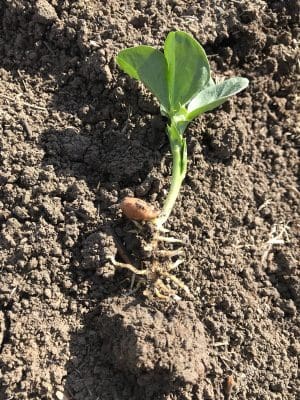THE ABILITY of pulse crops to germinate from depth has given them a late run in some winter-cropping programs across New South Wales, where continuing dry conditions are cribbing yield potential from cereals in the state’s northern half.

Faba beans are among the pulses making a comeback in southern NSW this year. Photo: Grassroots Agronomy
B&W Rural Moree principal, Peter Birch, said the season has seen “an awful lot” of winter crop sown dry.
“We had some storms north of Moree from Fox’s Lane to North Star in mid-April, but in general, most of the area has been dry sown, and without 25millimetres of rain, it won’t shoot or get going,” Mr Birch said.
“It’s been a long time since it hasn’t rained in Moree in May.”
The lack of rain on the forecast for northwest NSW, typically the state’s powerhouse of chickpea and high-protein milling wheat production, has some growers planting chickpeas into area they had planned to fallow over winter in readiness for sorghum and dryland cotton.
“There are people sowing chickpeas now at a depth of 15-18 centimetres, and rolling or double- rolling or Kelly-chaining them in to stop the topsoil from drying out.
“They’re picking their best paddocks that were destined for summer crop and going in with chickpeas, but if we get to July without rain, a lot will wait for summer crop.”
Mr Birch estimated growing areas east of the Newell Highway, including the prized North Star region northeast of Moree, had 10 per cent of its crop established, with a further 10pc “in and patchy”, and the balance dry sown and waiting for germination rain, or yet to be planted.
West of the Newell Highway, Mr Birch said around 10pc of the planted winter crop was established, and a further 10-20pc was dry sown and waiting for rain.
“Apart from that, west of the Newell, and particularly southwest of Moree, has nothing in because they would need 100mm to get things started.”
“Eastern areas have reasonable subsoil moisture, so their yield prospects aren’t too bad, but a lots of areas are behind the 8-ball now.”
Feed pulses popular
Growers on the southwest and southern slopes of NSW, and pockets of the adjacent plains areas, have had the best of the NSW season to date, and Cootamundra-based Pulse Australia agronomist, Phil Bowden, said pulses were working their way into 2018 rotations.
“There’ll be reasonable areas of lupins, faba beans and field peas go in this season because the prices are pretty good at $350-$400 a tonne, and there’s such a big demand for them from the livestock sector,” Mr Bowden said.
Pulse areas in the state’s south has fallen away in recent years in response to low prices relative to the wider region’s most popular break crop, canola, and concerns about the disease, anthracnose.
“I’d say we’ll be back to our normal pulse area this year, as fabas have a good gross margin, and field peas do too.”
“A few people have experimented with lentils, but the price has dived and they’re not worth growing in this region this year.”
Mr Bowden said some early sown canola and dual-purpose wheats were being grazed, and most areas had had showers in the past week or two to aid germination and establishment.
“We’ve had a few little rain events, and a lot of winter crop was planted dry and on time, but some of it is struggling.”
“It’s not too bad around Cootamundra, but out around Temora and West Wyalong, things start to tail off.”
“Little patches are looking okay, and it depends on soil types, and whether people had some reasonable rain in January and February to give them subsoil moisture.”
Mr Bowden said few crops in southern NSW had had enough rain to link up topsoil and subsoil moisture.
Northern pinch
At Walgett, private agronomist, Greg Rummery, estimated only 1-2pc of the district’s planned winter crop had emerged.
“More than normal — maybe 10pc — has been sown dry, and it’ll need a minimum of 25mm of rain to get it going,” Mr Rummery said.
“The seasonal forecast says we’ll get a bit wet in June-July, but we’ll need to get very wet for this crop to do anything much.”
Mr Rummery estimated only 20pc of Walgett’s cropping area had “meaningful subsoil” through either long fallow, rain, or both.
“Anything that was a legume in 2016 and fallowed in 2017 has some moisture under it, but to get average yields, we need above-average rain from here on in.”
Delta Agribusiness Narrabri sales consultant, Malcolm Nalder, said the district’s fodder crops sown around mid-March were struggling or “just about dead”.
“Out west, some chickpeas are going in, and we could still plant a lot of winter crop well into July,” Mr Nalder said.
Mr Nalder said inquiry was centred on quick-maturing wheat varieties like Mustang and Dart, but growers would need a confident forecast for rain before they would plant.
Central conditions mixed
Ag N Vet central NSW agronomist, Matt McRae, agronomist said crops east of Forbes were mostly well established, and patchy rain in areas south had seen some crops get off to a reasonable start.
However, districts north and west of Forbes were mostly struggling.
“Some rain has come through and gotten some people out of the fire and back into the frying pan.”
“There’s some barley, oats and a little bit of wheat up and away, but we’re really sweating on this change coming through on the weekend.
“It all comes down to spring now, and what is hopefully a mild winter with low evaporation.”
Agronomists have stressed that wheat can be planted with confidence in June or early July, and said their clients were hopeful of a kind spring to get the crop through and generate pasture growth for sheep and cattle to graze.



HAVE YOUR SAY